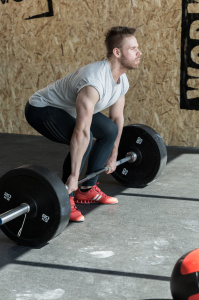 Forceful lifting is often overlooked as a key variable that can produce strength gains. People often understand the concept of increasing sets and reps to increase total workload. They also understand the concept of doing as many reps as possible within a set which is emphasized with high intensity training. While these two concepts were emphasized in regard to the role they play in gaining strength in the last two articles, the emphasis of this article will be in reference to the use of applying maximum force into each rep as a means for producing strength gains.
Forceful lifting is often overlooked as a key variable that can produce strength gains. People often understand the concept of increasing sets and reps to increase total workload. They also understand the concept of doing as many reps as possible within a set which is emphasized with high intensity training. While these two concepts were emphasized in regard to the role they play in gaining strength in the last two articles, the emphasis of this article will be in reference to the use of applying maximum force into each rep as a means for producing strength gains.
Clarifying the Use of Forceful Lifting
Lifting forcefully simply means to push or pull as hard as possible throughout the whole lifting motion of a rep. When emphasizing forceful lifting, the greatest potential for force production occurs at the start of a set before fatigue begins to interfere with force production. This being true, the start of set is emphasized, and the end of a set is often deleted. This basically means that you may use a weight that allows you to perform ten or more reps, but you will only do three to five reps. When using this method, you never strive to do as many reps as possible for a set, instead, you strive to perform each rep with as much force as possible and quickly terminate the set before fatigue causes a decrease in force production.
Forceful Lifting is Used by Elite Lifters
The West Side lifters are notoriously strong and rely upon forceful lifting as one of the components to their success. They refer to their focus on forceful lifting as dynamic effort, or speed training for bench, squat, or deadlift. This is not done with super heavy weights, but with weights that consist of about 50 to 60% of their single rep max for a lift. It must be clarified though that they do their dynamic effort speed lifting in conjunction with bands and chains, which causes the resistance to increase throughout the range of motion. While the resistance at the start of the lifting motion is only 50 to 60% of their single rep max for a lift, the amount of resistance at the top of the lifting motion may be as much as 70 to 80% of their single rep max. Even with bands and chains, the reps are done at a very fast speed.
When to Use Forceful Lifting
Forceful lifting with lighter weights and a moderate total workload is a fabulous way to promote active recovery after a taxing phase of training. Utilizing a short phase where seven to ten sets of three reps are used with weights that consist of 55 to 65% of your single rep max will provide you with a workout(s) that optimize your body for heavier lifting. Let’s look at some examples of when to use forceful lifting with moderate weights and a moderate total workload.
Forceful Lifting for Active Recovery
If you have done a phase of lifting that was very taxing in terms of high total workload, or high intensity training, you would be much better off recovering to some degree before going into a heavy phase of training with heavy weights. This is where forceful lifting with moderate weights and a moderate total workload would be ideal in preparation for heavy weights. When your body feels reenergized from the lighter workout(s), then head into the heavier lifting phase.
Forceful Lifting with a Linear Cycle
If you prefer linear periodization, you may notice that the end of a linear periodization cycle consists of so much slow reps with heavy weights that your body loses some of its firing power. Once you hit 80 to 85% of your single rep max in a linear cycle, start including one day per week with forceful lifting and lighter weights. Do at least 18 total reps, but don’t do any more than 30 total reps per exercise as you want to energize your muscles for heavier lifting, not drain them.
When you combine forceful lifting while using moderate weights with a gradual increase of weight over weeks, months, and years, you have an excellent formula for long term progression. If you can slightly increase the weight over and over again without slowing down on your rep speed, you will get progressively stronger. The systematic use of forceful lifting can make a big difference in your long term training success and you can consider using it if you are not using it already. Best of training to you.
